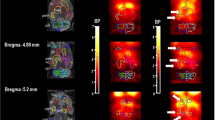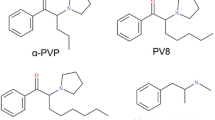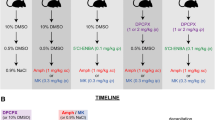Summary
The preferential dopamine autoreceptor, and slightly D3 preferring, antagonist (+)-UH232 (cis-(+)-(1S,2R)-5-methoxy-1-methyl-2-(n-dipropylamino) tetralin) increases locomotor activity and synaptic dopamine release in the nucleus accumbens and striatum after systemic administration to the rat. As shown in this study, (+)-UH232, was unable to produce anincrease in locomotor activity measured for 60 minutes after local administration into the terminal or somato-dendritic regions of the mesolimbic dopamine pathways or into the lateral ventricle. Instead, a dose dependent decrease of spontaneous locomotor activity after local application (0.05–50.0 nmol/ side) of (+)-UH232 into the nucleus accumbens, was seen. A similar reduction in locomotor activity was produced by the classical dopamine antagonist raclopride. Analysis of the dose*time interactions on locomotor activity did, however, indicate that there is a significant dose*time interaction after local application of (+)-UH232 into the lateral ventricle and VTA. Raclopride, on the other hand, produced only a weak time dependent effect in the VTA. The potential problem of Leao's spreading depression in micro-injection experiments were considered, however, spreading depression does not seem to influence the effects of (+)-UH232 locally applied into the nucleus accumbens. In conclusion, both (+)-UH232 and raclopride produced a dose dependent decrease in spontaneous locomotor activity when examined as the total activity count over 60 minutes after local application into the N Acc.
Similar content being viewed by others
References
Ahlenius S (1992) Effects of the local application of 3-PPP and sulpiride enantiomers into the nucleus accumbens or into the ventral tegmental area on rat locomotor activity: evidence for the functional importance of somatodendritic autoreceptors. Naunyn Schmiedebergs Arch Pharmacol 345: 516–522
Bunney BS, Walters JR, Roth RH, Aghajanian GK (1973) Dopaminergic neurons: effect of antipsychotic drugs and amphetamine on single cell activity. J Pharmacol Exp Ther 185: 560–571
Bures J, Buresova O, Krivanek J (1974) The mechanism and application of Leao's spreading depression of electroencephalographic activity. Academic Press, New York London
Carboni E, Imperato A, Perezzani L, Di Chiara G (1989) Amphetamine, cocaine, phencyclidine and nomifensine increase extracellular dopamine concentrations preferentially in the nucleus accumbens of freely moving rats. Neurosci 28: 653–661
Clark D, Engberg G, Pileblad E, Svensson TH, Carlsson A, Freeman AS, Bunney BS (1985) An electrophysiological analysis of the actions of the 3-PPP enantiomers on the nigrostriatal dopamine system. Naunyn Schmiedebergs Arch Pharmacol 329: 344–354
Costall B, Naylor RJ (1979) Behavioural aspects of dopamine agonists and antagonists. In: Horn AS, Korf J, Westerink BHL (eds) The neurobiology of dopamine. Academic Press, London, pp 555–576
Imperato A, Di Chiara G (1984) Trans-striatal dialysis coupled to reverse phase high performance liquid chromatography with electrochemical detection: a new method for the study of the in vivo release of endogenous dopamine and metabolism. J Neurosci 4: 966–977
Kling-Petersen T, Ljung E, Svensson K (1994) The preferential dopamine autoreceptor antagonist, (+)-UH232, antagonizes the positive reinforcing effects of cocaine and d-amphetamine in the ICSS paradigm. Pharmacol Biochem Behav 49: 345–351
Kling-Petersen T, Ljung E, Wollter L, Svensson K (1995a) Behavioural effects of the dopamine D3- and autoreceptor preffering antagonist, (−)-DS121, on locomotor activity and in the conditioned place preference and intracranial self-stimulation paradigms. Behav Pharmacol 6: 107–115
Kling-Petersen T, Ljung E, Wollter L, Svensson K (1995b) Effects on locomotor activity after local application of D3 preffering compounds in discrete areas of the rat brain. J Neural Transm [GenSect] 101: 27–34
Leao AAP (1944) Spreading depression of activity in the cerebral cortex. J Neurophysiol 7: 359–390
Magnusson O, Fowler CJ, Mohringe B, Wijkström A, Ögren S-O (1988) Comparison of the effects of haloperidol, remoxipride and raclopride on “pre”- and postsynaptic dopamine receptors in the rat brain. Naunyn Schmiedebergs Arch Pharmacol 337: 379–384
Meller E, Bohmaker K, Goldstein M, Bashman DA (1993) Evidence that striatal synthesis-inhibiting autoreceptors are dopamine D3 receptors. Eur J Pharmacol 249: R5-R6
Mogenson GJ, Jones DL, Yim CY (1980) From motivation to action: functional interface between the limbic system and the motor system. Prog Neurobiol 14: 69–97
Nicholson C, Kraig RP (1981) The behavior of extracellular ions during spreading depression. In: Zeuthen T (ed) The application of ion-selective microelectrodes. Elsevier, Amsterdam, pp 217–238
Ögren SO, Hall H, Köhler C, Magnusson O, Sjöstrand S-E (1986) The selective dopamine D2 receptor antagonist raclopride discriminates between dopamine-mediated motor functions. Psychopharmacology 90: 287–294
Piercey MF, Lum JT, Hoffmann WE, Carlsson A, Ljung E, Svensson K (1992) Antagonism of cocaine's pharmacological effects by the stimulant dopaminergic antagonists, (+)-AJ76 and (+)-UH232. Brain Res 588: 217–222
Radhakishun FS, van Ree JM (1987) The hypomotility elicited by small doses of apomorphine seems exclusively mediated by dopaminergic systems in the nucleus accumbens. Eur J Pharmacol 136: 41–47
Sokoloff P, Giros B, Martres M-P, Bouthenet M-L, Schwartz J-C (1990) Molecular cloning and characterization of a novel dopamine receptor (D3) as a target for neuroleptics. Nature 347: 146–151
Sonesson C, Waters N, Svensson K, Carlsson A, Smith MW, Piercey PF, Meier E, Wikström H (1993) Substituted 3-phenylpiperidines: new centrally acting dopmaine autoreceptor antagonists. J Med Chem 36: 3188–3195
Svensson K, Johansson AM, Magnusson T, Carlsson A (1986) (+)-AJ76 and (+)-UH232: central stimulants acting as preferential dopamine autoreceptor antagonists. Naunyn Schmiedebergs Arch Pharmacol 334: 234–245
Svensson K, Kling-Petersen T, Waters N, Ekman A, Carlsson A (1991a) The preferential dopamine autoreceptor antagonist (+)-AJ76 increases motor activity in habituated rats and antagonizes d-amphetamine-induced hyperactivity. Post Neurosci 1: 75–79
Svensson K, Thorngren M, Wollter L, Carlsson A (1991b) The dopamine (D3 prefering) autoreceptor antagonists (+)-AJ76 and (+)-UH232 produce conditioned place preference in the rat. Soc Neurosci Abstr 17: 1352
Svensson K, Waters N, Sonesson C, Wikström H, Nichols N, Carlsson A (1993) (−)-DS121, a novel dopamine D3- and autoreceptor preferring antagonist: effects on locomotor activity in the rat. Soc Neurosci Abstr 19, part 1: 80
Swanson LW (1993) Brain maps: structure of the rat brain. Elsevier, Amsterdam, p 240
Vinogradova LV, Koroleva VI, Bures J (1991) Re-entry waves of Leao's spreading depression between neocortex and caudate nucleus. Brain Res 538: 161–4
Waters N, Lagerkvist S, Löfberg L, Piercey M, Carlsson A (1993) The dopamine D3 receptor and autoreceptor preferring antagonists (+)-AJ76 and (+)-UH232; a microdialysis study. Eur J Pharmacol 242: 151–163
Waters N, Hansson L, Löfberg L, Carlsson A (1994) Intracerebral infusion of (+)-AJ76 and (+)-UH232: effects on dopamine release and metabolism in vivo. Eur J Pharmacol 251: 181–190
Westerink BHC, de Vries JB (1989) On the mechanism of neuroleptic induced increase in striatal dopamine release: brain dialysis provides direct evidence for mediation by autoreceptors localized on nerve terminals. Neurosci Lett 99: 197–202
Wolf ME, Roth RH (1987) Dopamine autoreceptors. In: Creese I, Frazer CM (eds) Receptor biochemistry and methodology. Alan R Liss, New York, pp 45–96
Author information
Authors and Affiliations
Rights and permissions
About this article
Cite this article
Kling-Petersen, T., Ljung, E., Waters, N. et al. Effects on locomotor activity after local application of (+)-UH232 in discrete areas of the rat brain. J. Neural Transmission 103, 331–341 (1996). https://doi.org/10.1007/BF01271244
Received:
Accepted:
Issue Date:
DOI: https://doi.org/10.1007/BF01271244




